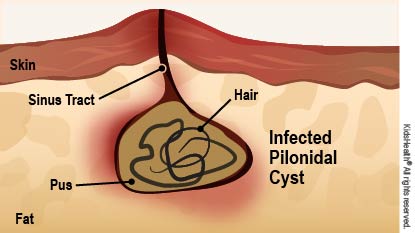Infected Pilonidal Cyst: How to Care for Your Child
A pilonidal cyst is a fluid-filled sac just under the skin close to the tailbone (coccyx), near the crease of the buttocks. It can become infected and fill with pus. An infected pilonidal (pie-luh-NIE-dul) cyst is also called a pilonidal abscess. An infected pilonidal cyst is painful, red, and swollen. It may drain pus or blood onto the skin through an opening called a sinus tract. It also can cause a fever.


-
If antibiotics were prescribed, give them to your child as directed.
-
Schedule a follow-up visit as directed.
If your health care provider drained the cyst:
-
Follow instructions for when to change or remove the bandage covering the area where the incision (cut) was made.
-
Your child should not take a bath or swim until the health care provider says it's OK.
-
After the incision heals:
-
Clean the area as directed.
-
Your child should avoid sitting for long periods of time.
-
Your child may be more comfortable sleeping on the side or stomach.
-
If your health care provider tells you to, regularly remove hair from the area by using a depilatory cream (a cream that removes hair from the skin surface). Permanent hair removal, such as laser hair removal, also may be an option.
If your health care provider didn't drain the cyst, you can:
-
Hold a warm, moist washcloth to the cyst area.
-
Have your child sit in a bath of warm water that covers the cyst.

Your child has:
-
increased or continued redness, swelling, or pain around the cyst
-
increased or continued pus or blood draining from the cyst
-
changes to the cyst or the area around it, such as a small hole in the skin near the cyst

Your child has a fever of 100.4°F (38°C) or higher, or chills.

What causes a pilonidal cyst? It's thought that most pilonidal cysts form when loose hair and dead skin cells get trapped beneath the skin. They get forced deeper into the skin by friction and pressure from things like long periods of sitting, tight clothing, or bicycling. The body's immune system treats the hair and dead skin cells as foreign, forming a cyst around them that fills with fluid.
How is an infected pilonidal cyst treated? Treatment depends on how severe the infection is. Mild infections can be treated with sitz baths and warm compresses. When a cyst remains infected, health care providers make a small cut that lets fluid, hair, and other material drain out. They might give antibiotics if the infection spreads to the skin around the cyst.
Can we prevent a pilonidal cyst from becoming infected again? After the infection heals, your health care provider may suggest surgery to treat the condition and prevent future infections or new cysts. In one type of surgery, called the Gips procedure, a health care provider uses a small surgical tool to remove the sinus tract, and then cleans out the hair and debris from inside the cyst. Even after surgery, pilonidal cysts can sometimes happen again. Keeping the area clean and free of hair can help prevent infection and new cysts.